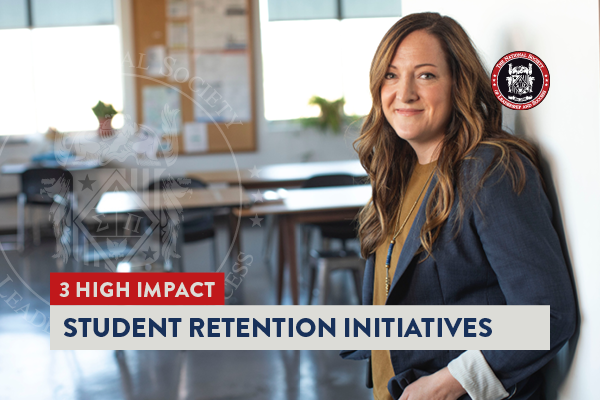By Stacey Malaret, Ed.D.
As a college student in a new environment, establishing a healthy independent sense of self is dependent on a student’s sense of belonging, which leads to student retention. A sense of belonging is defined as the “psychological sense that one is a valued member of the college community” (Hausmann, Schofield, & Woods, 2007, p. 804).
High impact student retention initiatives are one of the ways that a student can overcome the difficulty of finding a sense of community on campus and create this sense of belonging. By facilitating the opportunity for students to become part of a smaller grouping where a sense of community is already established, high impact practices help students adjust to college life and more easily develop their sense of belonging. As a result of a student’s engagement in high impact initiatives, student retention will become more probable.
Common High Impact Practices to Improve Student Retention
George Kuh (2008) defines high impact practices as those that “educational research suggests increase rates of student retention and student engagement” (p. 9). Common high impact practices include:
- First year seminars/experiences
- A core curriculum
- Writing-intensive courses
- Collaborative assignments
- Undergraduate research
- Diversity/global learning
- ePortfolios
- Service-learning
- Internships
- Capstone projects
- Living Learning Communities
This article will focus specifically on learning living communities, service-learning, and academic leadership programs as retention-based initiatives.
3 High-Impact Retention-Based Initiatives
Student retention has always been a major concern for higher education leaders and administrators and is even more important now with all the uncertainty that 2020 has presented. As institutions search for ways to retain students, they are struggling to identify techniques to engage students to develop their sense of belonging and connection to the school through virtual environments.
Below are three initiatives that solve this problem, all of which can be implemented in a virtual, in-person, or hybrid experience.
1. Living Learning Community (LLC)
One high impact practice to note that has proven to report high GPAs and retention rates is the Living Learning Community (LLC) experience.
Kuh (2008) stated, “The key goals for learning communities are to encourage integration of learning across courses and to involve students with ‘big question’ that matter beyond the classroom. Students take two or more linked courses as a group and work closely with one another and with their professors. Many learning communities explore a common topic and/or common readings through the lenses of different disciplines. Some deliberately link ‘liberal arts’ and ‘professional courses’; others feature service learning” (p. 10).
Previous analyses have shown that high impact educational practices, such as learning communities, have particularly positive benefits for first-year students (Kuh, 2008).
LLCs date back to the start of the 1920s when there was an experimental version of a college community that was put into place. The idea was revised in the 1960s but the version of these communities that we know today was modernized in the 1980s. After this time, it was proven that a student’s performance increased if learning occurred both inside and outside of the classroom.
The dual level of engagement and recognition not only enhanced academic performance but became an intellectual indicator of extracurricular and academic performance. Students with like-minded interests are usually attracted to a particular type of community, and it reflects in their group norms and performance (Meih Zhao & Kuh, 2004).
A sense of belonging is pivotal for student success and retention, and these LLCs facilitate that through providing social and academic support in ways that traditional residential experiences do not (Spanierman et al., 2013).
2. Service-Learning
In regard to service-learning and its benefits for students, there are several studies that support its positive effects. Service-learning allows students to be productive citizens in their community while using curriculum obtained through coursework. This allows for students to take information they learned in the classroom and put that theory into practice in the community.
Service-learning provides students with the opportunity to give back to their community while also learning why the services are important and then applying material that they learned in the classroom to real-life situations (Schmidt, 2004).
Service-learning has increasingly been used to create a more engaged academic environment. A student’s participation in service-learning can also improve their perception of their institution. Other studies have shown that service-learning allows students to gain a stronger understanding of others and themselves as well as creating a sense of civic responsibility, and a stronger understanding of social issues (Schmidt, 2004).
Still other studies have shown that service-learning enhances student engagement and commitment to their school, is a powerful tool for creating contributing citizens, has an impact on their social and emotional development, and can enhance the curricular goals of a course in which it is embedded (Strage, 2004).
3. Academic Leadership Programs
In looking at Schlossberg’s transition theory and analyzing the first-year transition to college, it has been proven that activities provided through academic leadership programs enhance the student experience and have factored in student success.
At the University of Nebraska, Alison P. TePoel completed a thesis studying a leadership program on their campus. It was proven using the theory that the four S’s (situation, self, support, and strategies) were instrumental for the students who were a part of this program. In her analysis of first-year student success, these students retained at a higher rate and felt more connected and engaged to their community and school during their first year in college (TePoel, 2012).
Leadership programs that include living-learning communities, academic coursework, and service-learning are especially beneficial with retention because they are combining the beneficial elements of those initiatives with outcome-based results.
An engaging leadership program will include elements such as:
- Active community that supports and challenges members.
- Develop strong bonds through smaller group breakout sessions.
- Accredited educational program.
- Encouraging members to participate in community engagement, volunteer efforts, and service-learning.
These types of programs help students develop the interpersonal skills needed in the modern workplace and prepare them for their first internship or job.
The Importance of Student Retention Initiatives
Many studies assess collegiate involvement in regards to retention and the psychological perspective to first-year students who are a part of an organizational program using theories from Chickering and Reisser, and the seven vectors:
- Developing competence
- Managing emotions
- Moving through autonomy toward interdependence
- Developing mature interpersonal relationships
- Establishing identity
- Establishing and clarifying purpose
- Developing integrity
After linking to Astin’s Theory on student involvement, Chickering and Reisser were able to prove that students who were actively involved and engaged had a higher sense of motivation and belonging to their university. The students also developed a higher purpose as well as need for gradual development.
These theories collectively strengthen the need for high impact programming but also show that through these models that students are retained because of these practices and close the gap for failure upon returning (Foubert & Urbanski, 2006).
Implement Retention-Based Initiatives
High impact student retention initiatives have impacted not only the students but the university at large. Due to these engaging experiences both through service, leadership programs, and learning within their living spaces, these students have not only been retained to the university at a higher rate but have been more engaged citizens.
This sense of belonging and connected community is even more important in a virtual or hybrid environment where students don’t have many of the same opportunities to engage peers, faculty, and staff as they did in previous years. Implementing one or more of these high impact initiatives can help grow the sense of community at your school and develop students’ skills beyond the classroom.
Are you struggling to create virtual events that students actually want to attend? Read our eBook: The Ultimate Guide to Improving Virtual Student Engagement to learn the five elements of an engaging virtual event.
 Dr. Stacey Malaret is originally from Orlando, Florida and attended The University of Southern Mississippi for her B.A. degree in Psychology. She then graduated in 1998 from The University of Central Florida with a M.A. in Student Personnel and in 2007 with her Doctorate in Educational Leadership. She has worked in the student development field since 1999. She is the current director for the LEAD Scholars Academy and has worked at UCF since 2001 with LEAD as assistant director, associate director and now as the director since 2010. She also teaches for CCIE for the Higher Education and Student Personnel program and Strategies for Success each semester. Her research interests include leadership development, gender studies, anti-hazing initiatives and high impact practices.
Dr. Stacey Malaret is originally from Orlando, Florida and attended The University of Southern Mississippi for her B.A. degree in Psychology. She then graduated in 1998 from The University of Central Florida with a M.A. in Student Personnel and in 2007 with her Doctorate in Educational Leadership. She has worked in the student development field since 1999. She is the current director for the LEAD Scholars Academy and has worked at UCF since 2001 with LEAD as assistant director, associate director and now as the director since 2010. She also teaches for CCIE for the Higher Education and Student Personnel program and Strategies for Success each semester. Her research interests include leadership development, gender studies, anti-hazing initiatives and high impact practices.
References:
Foubert, J. D., & Urbanski, L. A. (2006). Effects of Involvement in Clubs and Organizations on the Psychosocial Development of First-Year and Senior College Students. NASPA Journal, 43(1). doi:10.2202/0027-6014.1576
Hausmann, L. R. M., Schofield, J. W., & Woods, R. L. (2007). Sense of belonging as a predictor of intentions to persist among African American and White first-year college students. Research in Higher Education, 48(7), 803–839
Kuh, G. D. (2008). High-impact educational practices: What are they, who has access to them, and why they matter. Washington, DC: Association of American Colleges and Universities.
Schmidt, M., Marks, J., & Derrico, L. (2004). What a Difference Mentoring Makes: Service Learning and Engagement for College Students. Mentoring & Tutoring: Partnership in Learning, 12(2), 205-217. Retrieved from ERIC database.
Spanierman, L. B., Soble, J. R., Mayfield, J. B., Neville, H. A., Aber, M., Khuri, L., & De La Rosa, B. (2013). Living learning communities and students’ sense of community and belonging. Journal of Student Affairs Research and Practice, 50(3), 308–325. doi:10.1515/jsarp-2013-0022
Strage, A. (2004). Long-Term Academic Benefits of Service-Learning: When and Where Do They Manifest Themselves? College Student Journal, 38(2), 257-261.
TePoel, A. P. (2012). Chancellor’s Scholars Program: Exploring the Transitional Influence on Freshmen College Students (Unpublished master's thesis). University of Nebraska-Lincoln. Doi: http://digitalcommons.unl.edu/cgi/viewcontent.cgi?article=1089&context=cehsedaddiss
Zhao, C.M.; Kuh, G.D. (2004). Adding Values: Learning Communities and Student Engagement. Research in Higher Education, 45(2), 115-138





